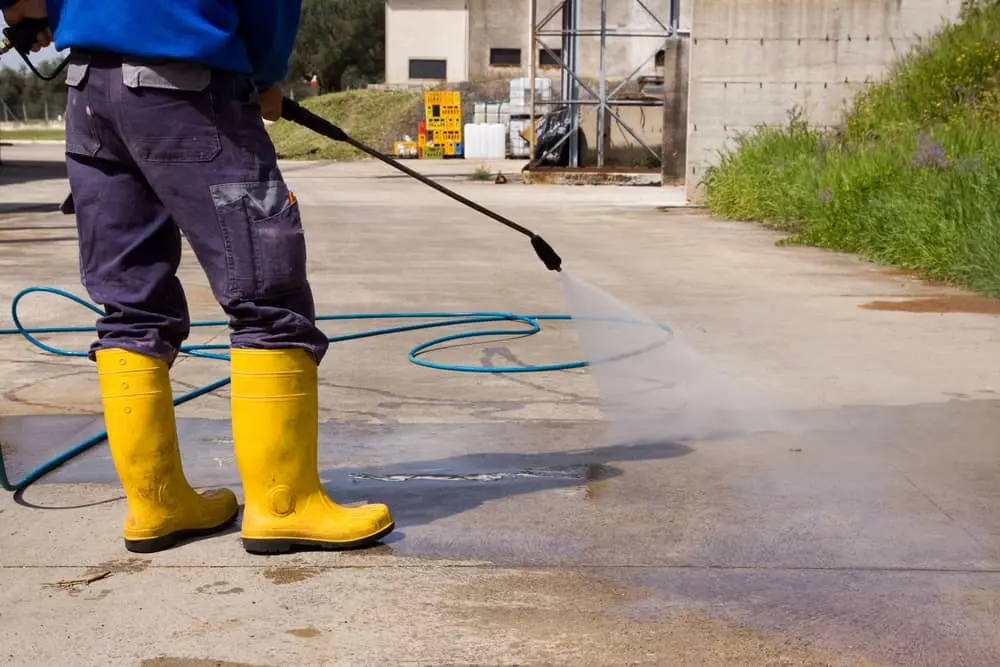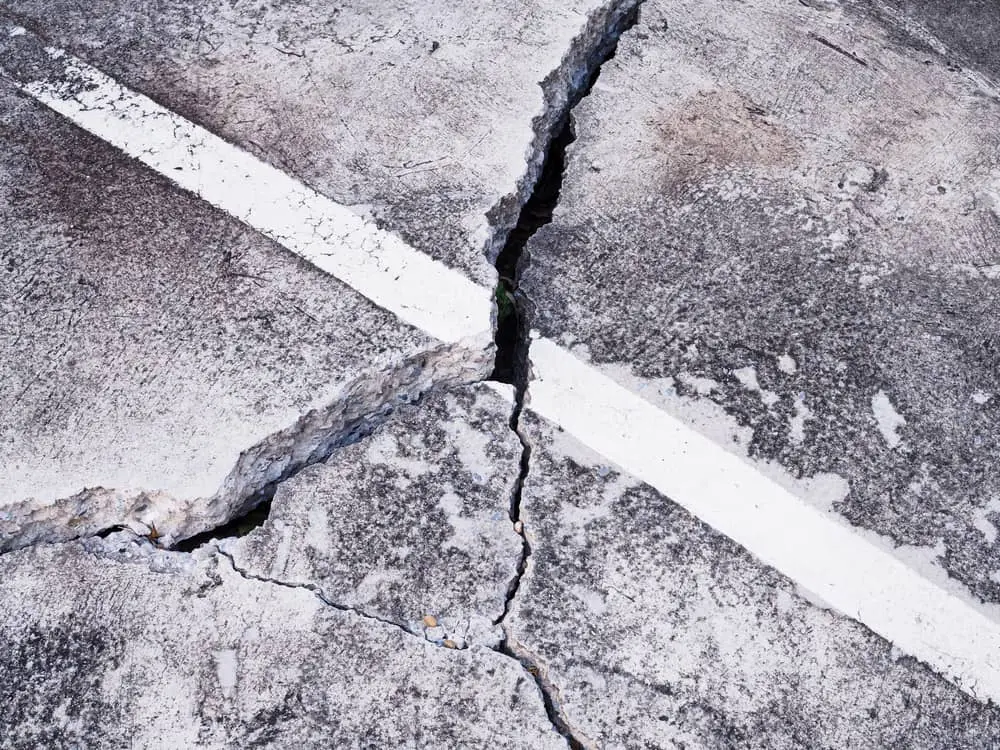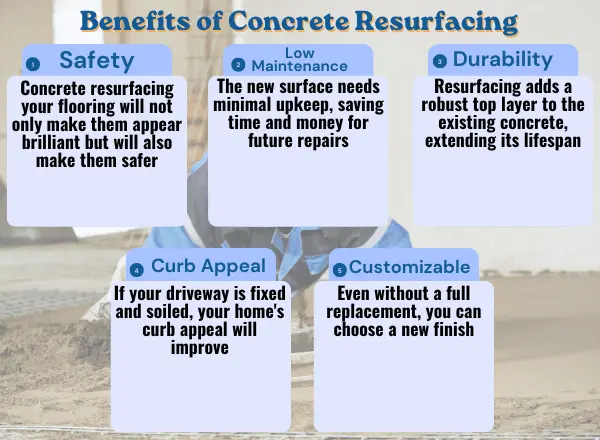Pressure washing or power washing your concrete is essential to keep it looking new. It helps your concrete last for the following years when combined with resurfacing. So, how do you clean concrete before resurfacing?
Pressure washers are often the go-to, at-home tool for cleaning concrete, but they lack certain features that make them ideal for heavy-duty cleaning.
On the other hand, power washers are equipped with more tools to do the job well, such as higher pressure and heating elements.

Cleaning concrete can improve curb appeal, enhance longevity, and prepare it for resurfacing.
Concrete that needs to be properly cared for will deteriorate significantly faster. Removing mold or moss growing on your concrete eliminates a danger to its integrity.
Once plant matter grows on your concrete, it sends tiny tendrils or roots into the pores of the concrete slab. Eventually, this can break down the surface, leading to flaking off or spalling of the concrete.
Also, oils and salts can penetrate the surface of the concrete and speed up its breakdown.
Concrete is subject to wear and tear through time due to weather, foot traffic, and other environmental factors, resulting in cracks, stains, and a worn-out appearance. Concrete resurfacing resolves these issues, offering a fresh, top layer that makes the concrete appear brand-new without the cost of a complete replacement. You can even seize this opportunity to customize the concrete's color, pattern, and texture, creating the appearance of a completely new slab and boosting your property's aesthetics.
Although concrete is a durable, tough material, it will eventually show indications of deterioration and wear.
It is particularly true of driveways and other concreted areas constantly exposed to the elements. But take heart—most concrete, even somewhat damaged concrete, can be resurfaced rather than tearing it all out and replacing it, an expensive and time-consuming proposition.
Resurfacing is a work best left to the professionals. The prep work alone consumes too much time and must be done correctly for the resurfacing to be effective. Several steps must be taken to prepare the concrete before resurfacing. Concrete Designs has the experts and the proper tools and equipment to complete the job efficiently and quickly, leaving you with a like-new finish that lasts for years.
The first and very crucial step is thoroughly cleaning the concrete. All debris, dirt, paint, or sealant must be removed to bare concrete. You would not paint a dirty wall and expect it to appear flawless; you cannot resurface dirty concrete and expect perfect results. The resurfacing material bonds to the concrete and strengthens it. This will only happen if the concrete is completely clean, leaving you with a less-than-ideal finish with weak spots.
When the concrete has been cleaned, any flaws will be exposed and must be addressed. If there are any bad spots, these need to be removed and replaced. Small hairline cracks must be filled; larger dents or cracks can be patched to fit the surrounding surface. The filled and patched locations need time to cure, often a few hours under the right conditions, before the next step is taken.
After cleaning the concrete, all patches and cracks are taken care of and cured. The surface must now be roughened to properly bond the resurfacing agent to the concrete. Roughing the surface requires equipment most people don't have around their garage. As the resurfacing is applied, a distressed or smooth, slip-resistant finish is easily achieved.
As you can see, prepping your concrete can be complicated if you try it as a do-it-yourself project. The expertise and knowledge of the personnel here at Floor Doctor make the job affordable and painless, providing a fresh new look to your tired, worn concrete without effort on your part.

In ideal conditions, concrete will have a level and uniform appearance. It shows that the top layer effectively blocks water or ensures a solid base for a building or structure.
Certain types of concrete floors get a lot more wear than others. Examples include garages, which regularly have very heavy vehicles driving on them. A concrete driveway may receive damage similarly. Driveways also don't ordinarily have any form of cover, which can contribute to the overall level of wear.
People must keep in mind the following when deciding whether their concrete surface needs repair:
Flaking and damage: If resurfacing is necessary, it is likely obvious from the floor's appearance. People can look for flaking and small pits on the concrete's surface. Scratches in paint or other finishes are also key indicators.
Spalling: People can look for spalling on the surface of the concrete. It shows a wrinkly look and is a sign that water is present on the surface. Spalling can commonly happen if the foundation is poorly stamped or when people use wire mesh in their foundation, which can cause rust and oxidation. Other causes include the salt people use to defrost ice in colder climates.

Cracked, broken, or damaged edges: The edges are a key problem on concrete slabs. They can degrade or crumble, particularly on driveways where vehicles frequently add pressure. People can search for these issues at the joints between their slabs. The outer edges are where you can look if the surface is a single pour.
The other factor indicating a floor may require resurfacing is the age of the concrete. This may take time to be obvious if people move into a new house. It is a good idea to ask about the concrete age when viewing houses, as it may signify that more work is necessary.
Poor-quality materials are a common and frustrating cause of cosmetic issues on a concrete surface. As professionals with many years of experience, we are especially disappointed to see this in the industry.
Concrete floor or driveway resurfacing provides numerous benefits:
Resurfacing removes the need to turn down and replace existing concrete, saving money on materials and labor.
The resurfacing process is much quicker than laying new concrete, with areas usually ready for traffic in just a few days.
Concrete resurfacing your flooring will not only make them appear brilliant but will also make them safer. Concrete with pits and cracks is more prone to trip hazards. Damaged concrete might cause tripping. Also, bacteria, mold, and moss can grow in small pits. We at Floor Doctor offer concrete resurfacing, and we ensure the repair of damaged concrete and even out the surface to minimize hazards for your family and friends' safety.
Your home is a financial asset. With typical use, a driveway will crack and blemish. Tree roots or mild earthquakes might damage it. However, if your driveway is fixed and soiled, your home's curb appeal will improve. Curb appeal isn't only about the appearance of your driveway. A skilled concrete coating can repair any concrete issues and safeguard them from further harm.
Even without a full replacement, you can choose a new finish with coloring, staining, or stamping, making it easy to match any landscaping or decor theme.

Resurfacing adds a robust top layer to the existing concrete, extending its lifespan and improving resistance to wear and tear.
The new surface needs minimal upkeep, saving time and money for future repairs.
Concrete resurfacing works best in areas with minor damage, so an extensive evaluation is required to determine if a surface suits this restoration method. Excessive cracking is a concern since it might suggest deeper issues like ground movement, possibly causing the resurfaced layer to crack. High moisture levels and dusting might also compromise the resurfacing process, resulting in delamination or damage.
Resurfacing does not solve structural problems, so replacing the concrete may be recommended in some cases. Even if the surface qualifies for concrete resurfacing, appropriate preparation and repair of large holes and pitting are crucial for a successful finished product.
Resurfacing might also not work if the surface has been sealed with epoxy, colored, etched, or stamped. In such cases, concrete resurfacing may not properly adhere to the existing surface, and it is advisable to remove the coating first.
To know more about concrete resurfacing, please contact us today!
